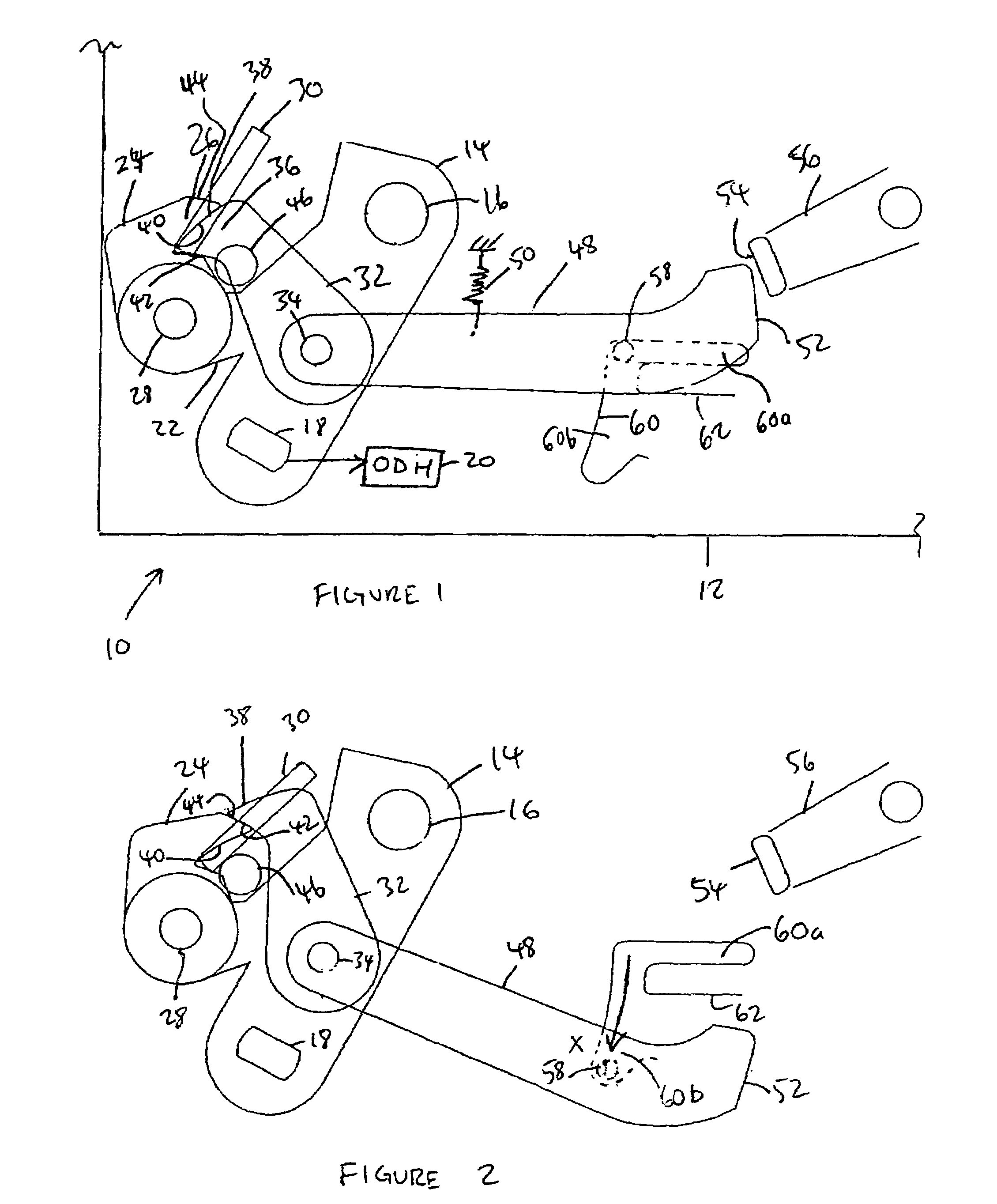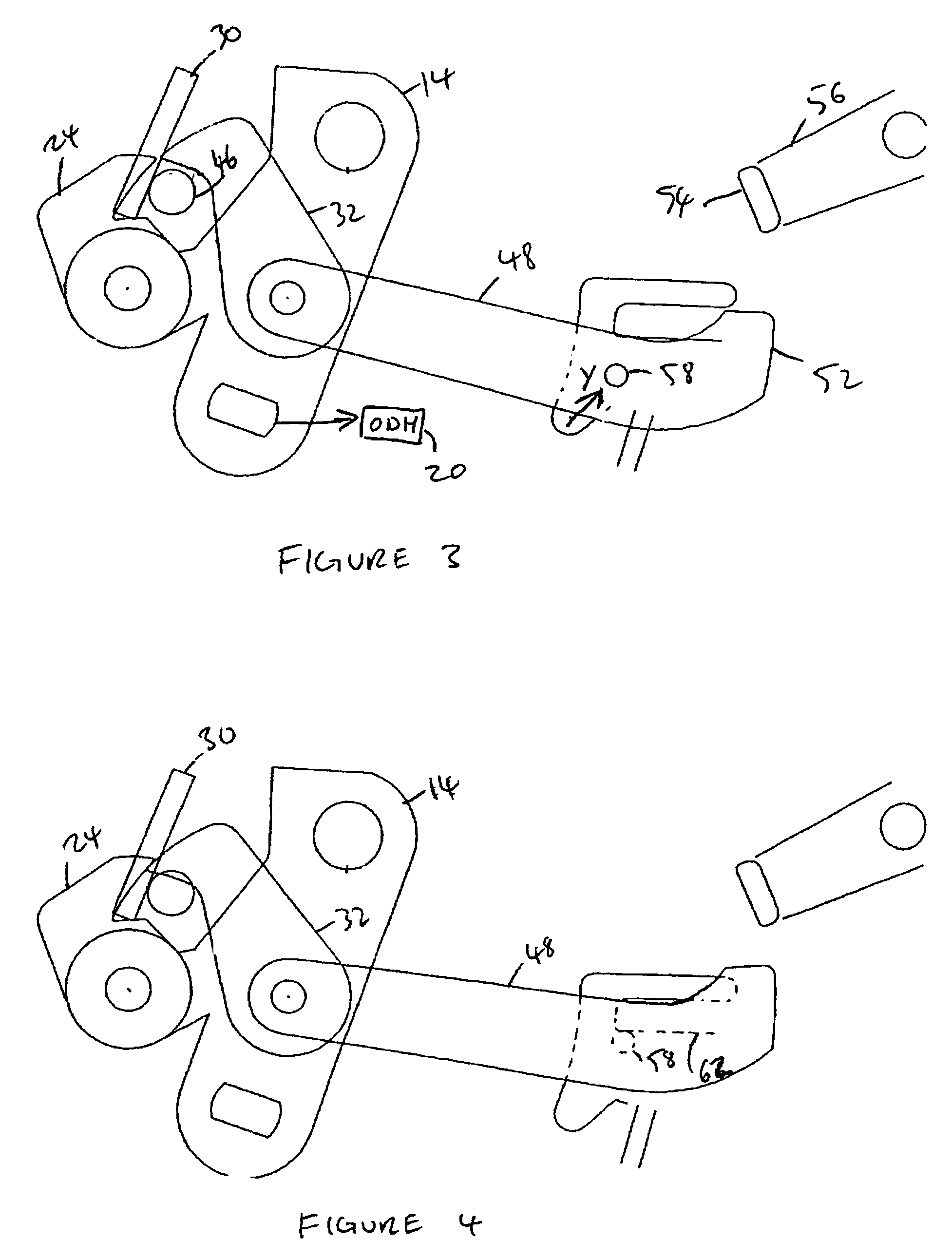Inertia locking mechanism
a locking mechanism and inertia technology, applied in the direction of carpet fasteners, locks, mechanical devices, etc., can solve the problems of undesirable unlatching of vehicle passenger doors to change their relative positions,
- Summary
- Abstract
- Description
- Claims
- Application Information
AI Technical Summary
Problems solved by technology
Method used
Image
Examples
second embodiment
[0043]FIGS. 6 to 9 illustrate another embodiment of the present invention. Similar parts among the different embodiments have been designated by like numerals with the addition of the prefix “1” wherever possible. Differences between the latch of the second embodiment with respect of the latch of the first are discussed in further detail below.
[0044]As shown in FIG. 6, the pawl and catch arrangement of the first embodiment has been dispensed with. In contrast with the transmission lever 48 of the first embodiment, the transmission lever 148 in the second embodiment is biased in a clockwise direction by a tension spring 150. The slot 160 is substantially triangular in shape. During normal operation, the projection 158 on the transmission lever 148 is maintained in an upper region of the slot 160 by an inertia body 170 pivotally mounted about a pin 172.
first embodiment
[0045]The inertia body 170 is resiliently biased in a counter-clockwise direction and is shown in its rest position in FIG. 6. An upper surface 176 of the inertia body 170 defines, together with the upper surface of the slot 160, an elongate slot portion 160a similar to the slot portion 60a of the However, due to the clockwise biasing of the transmission lever 148 in this embodiment, the projection 158 tends to contact the surface 176 of the inertia body 170 during movement along the slot portion 160a.
[0046]The inertia body 170 further comprises an inertia mass portion 174 remote from pin 172.
[0047]During normal operation, a vehicle user pulls on the outside door handle 120, causing the transmission lever 148 to move substantially linearly towards the actuating lever 156 while being guided by the movement of the projection 158 on the transmission lever 148 in a slot portion 160a. The abutment surface 152 of the transmission lever 148 contacts the abutment surface 154 of the actuat...
third embodiment
[0050]FIGS. 10 and 11 illustrates the present invention in which like parts have again been designated by like numerals, but with the addition of the prefix “2”. Again, only the differences between this embodiment and the first two embodiments are discussed in detail.
[0051]It can be seen that in this embodiment, the slots 60 and 160 of the first two embodiments have been dispensed with. Instead, a projection 258 on the transmission lever 248 rests in normal use in a notch 280 provided on the inertia body 270. When a user pulls on the outside door handle 220, the transmission lever 248 moves from left to right to contact the actuating lever 256 while the projection 258 on the transmission lever 248 is retained within the notch 280. The inertia body 270 rotates during this movement against the biasing force of the torsion spring 284.
[0052]During an impact, the inertia body 270 rotates in a clockwise direction in a similar manner to the inertia body 170 of the second embodiment. This c...
PUM
 Login to View More
Login to View More Abstract
Description
Claims
Application Information
 Login to View More
Login to View More - R&D
- Intellectual Property
- Life Sciences
- Materials
- Tech Scout
- Unparalleled Data Quality
- Higher Quality Content
- 60% Fewer Hallucinations
Browse by: Latest US Patents, China's latest patents, Technical Efficacy Thesaurus, Application Domain, Technology Topic, Popular Technical Reports.
© 2025 PatSnap. All rights reserved.Legal|Privacy policy|Modern Slavery Act Transparency Statement|Sitemap|About US| Contact US: help@patsnap.com



